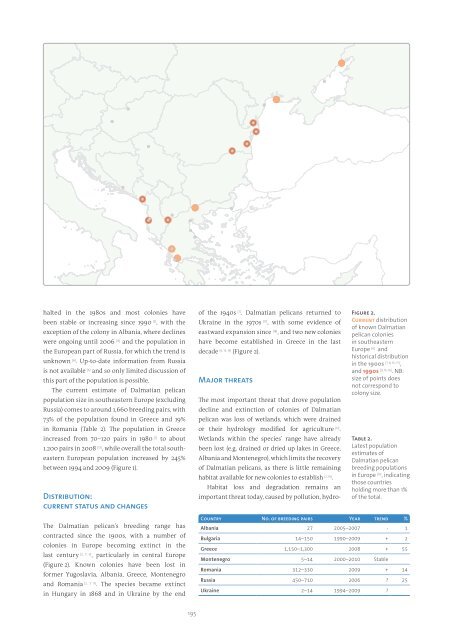130925-studie-wildlife-comeback-in-europe
You also want an ePaper? Increase the reach of your titles
YUMPU automatically turns print PDFs into web optimized ePapers that Google loves.
halted <strong>in</strong> the 1980s and most colonies have<br />
been stable or <strong>in</strong>creas<strong>in</strong>g s<strong>in</strong>ce 1990 [2] , with the<br />
exception of the colony <strong>in</strong> Albania, where decl<strong>in</strong>es<br />
were ongo<strong>in</strong>g until 2006 [13] and the population <strong>in</strong><br />
the European part of Russia, for which the trend is<br />
unknown [6] . Up-to-date <strong>in</strong>formation from Russia<br />
is not available [6] and so only limited discussion of<br />
this part of the population is possible.<br />
The current estimate of Dalmatian pelican<br />
population size <strong>in</strong> southeastern Europe (exclud<strong>in</strong>g<br />
Russia) comes to around 1,660 breed<strong>in</strong>g pairs, with<br />
73% of the population found <strong>in</strong> Greece and 19%<br />
<strong>in</strong> Romania (Table 2). The population <strong>in</strong> Greece<br />
<strong>in</strong>creased from 70–120 pairs <strong>in</strong> 1980 [7] to about<br />
1,200 pairs <strong>in</strong> 2008 [13] , while overall the total southeastern<br />
European population <strong>in</strong>creased by 245%<br />
between 1994 and 2009 (Figure 1).<br />
Distribution:<br />
current status and changes<br />
of the 1940s [7] . Dalmatian pelicans returned to<br />
Ukra<strong>in</strong>e <strong>in</strong> the 1970s [17] , with some evidence of<br />
eastward expansion s<strong>in</strong>ce [18] , and two new colonies<br />
have become established <strong>in</strong> Greece <strong>in</strong> the last<br />
decade [6, 13, 19] (Figure 2).<br />
Major threats<br />
The most important threat that drove population<br />
decl<strong>in</strong>e and ext<strong>in</strong>ction of colonies of Dalmatian<br />
pelican was loss of wetlands, which were dra<strong>in</strong>ed<br />
or their hydrology modified for agriculture [13] .<br />
Wetlands with<strong>in</strong> the species’ range have already<br />
been lost (e.g. dra<strong>in</strong>ed or dried up lakes <strong>in</strong> Greece,<br />
Albania and Montenegro), which limits the recovery<br />
of Dalmatian pelicans, as there is little rema<strong>in</strong><strong>in</strong>g<br />
habitat available for new colonies to establish [2, 19] .<br />
Habitat loss and degradation rema<strong>in</strong>s an<br />
important threat today, caused by pollution, hydro-<br />
Figure 2.<br />
Current distribution<br />
of known Dalmatian<br />
pelican colonies<br />
<strong>in</strong> southeastern<br />
Europe [6] and<br />
historical distribution<br />
<strong>in</strong> the 1900s [7, 8, 15–17] ,<br />
and 1990s [9, 15, 16] . NB:<br />
size of po<strong>in</strong>ts does<br />
not correspond to<br />
colony size.<br />
Table 2.<br />
Latest population<br />
estimates of<br />
Dalmatian pelican<br />
breed<strong>in</strong>g populations<br />
<strong>in</strong> Europe [13] , <strong>in</strong>dicat<strong>in</strong>g<br />
those countries<br />
hold<strong>in</strong>g more than 1%<br />
of the total.<br />
The Dalmatian pelican’s breed<strong>in</strong>g range has<br />
contracted s<strong>in</strong>ce the 1900s, with a number of<br />
colonies <strong>in</strong> Europe becom<strong>in</strong>g ext<strong>in</strong>ct <strong>in</strong> the<br />
last century [2, 7, 9] , particularly <strong>in</strong> central Europe<br />
(Figure 2). Known colonies have been lost <strong>in</strong><br />
former Yugoslavia, Albania, Greece, Montenegro<br />
and Romania [2, 7, 9] . The species became ext<strong>in</strong>ct<br />
<strong>in</strong> Hungary <strong>in</strong> 1868 and <strong>in</strong> Ukra<strong>in</strong>e by the end<br />
Country No. of breed<strong>in</strong>g pairs Year trend %<br />
Albania 27 2005–2007 - 1<br />
Bulgaria 14–150 1990–2009 + 2<br />
Greece 1,150–1,300 2008 + 55<br />
Montenegro 5–14 2000–2010 Stable<br />
Romania 312–330 2009 + 14<br />
Russia 450–710 2006 ? 25<br />
Ukra<strong>in</strong>e 2–14 1994–2009 ?<br />
195


